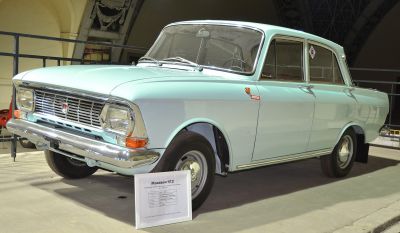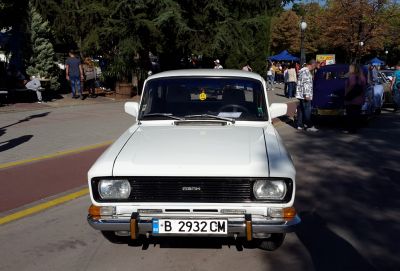 1969 Moskvich 412 IE Dimensions, Size & Specs
1969 Moskvich 412 IE Dimensions, Size & Specs
Measurements of the 1969 Moskvich 412 IE, engineered for optimal performance and comfort
| Dimensions | |
|---|---|
| Length: | 4250 mm167.3 in13.9 ft |
| Width: | 1550 mm61.0 in5.1 ft |
| Height: | 1480 mm58.3 in4.9 ft |
| Weight Specifications | |
| Curb Weight: | 1045 kg2304 lbs |
| Tire Specifications | |
| Tire Size: |
|
The Moskvich 412 IE is a classic Soviet sedan produced between 1969 and 1976. This generation of the Moskvich 412 embodies the practical and sturdy design typical of Moskvich cars from this era. It measures 4250 mm (167.3 inches) in length, 1550 mm (61.0 inches) in width, and stands 1480 mm (58.3 inches) tall, making it a compact yet functional vehicle suitable for urban and suburban driving. The car has a curb weight of approximately 1045 kg (2304 lbs), which reflects its robust construction while maintaining a manageable weight for efficient driving. Equipped with tires sized 165/80R13, the 412 IE offered balanced handling and road grip for its class. Overall, the Moskvich 412 IE sedan combines modest dimensions with the durability expected from Soviet-era vehicles, making it a notable model for enthusiasts of vintage compact sedans.
Discover the standout features that make the 1969 Moskvich 412 IE a leader in its class
Have a question? Please check our knowledgebase first.
The Moskvich 412 IE sedan measures 4250 mm (167.3 inches) in length, 1550 mm (61.0 inches) in width, and 1480 mm (58.3 inches) in height. These compact exterior dimensions reflect typical 1970s sedan design, making it a relatively small car compared to modern vehicles, favoring maneuverability especially in urban environments.
The Moskvich 412 IE has a curb weight of approximately 1045 kg (2304 lbs). This weight is fairly typical for compact sedans produced during the late 1960s and early 1970s. Its relatively light weight contributed to decent fuel efficiency and agility, which were important factors considering the technology and materials available at the time.
The Moskvich 412 IE uses 165/80R13 tires. This tire size strikes a balance between ride comfort and handling responsiveness. The 13-inch rims are on the smaller side by modern standards, contributing to a softer ride over rough roads, which was beneficial given the varied road conditions in the Soviet Union during the production years.
Yes, the Moskvich 412 IE's compact dimensions (4250 mm length and 1550 mm width) allow it to comfortably fit into a standard single-car garage, which typically accommodates vehicles up to 5 meters (approximately 16.4 feet) in length and 2.5 meters (8.2 feet) in width. Its size makes parking and storage convenient in residential settings.
While specific interior dimensions are less documented, the Moskvich 412 IE, like many sedans of its class and period, offers seating for up to five passengers. Thanks to its relatively efficient packaging within the 4250 mm length, the car provides adequate legroom and headroom for a compact sedan, delivering reasonable comfort for daily commutes and city driving.
Compared to the Moskvich 408, the 412 IE maintains very similar dimensions with minor alterations primarily in styling and mechanical enhancements. The 412 IE continues with a length around 4250 mm and a narrow width of 1550 mm, much like the 408, focusing more on performance and reliability improvements rather than drastic changes in size.
The Moskvich 412 IE stands 1480 mm (58.3 inches) tall. This moderate height ensures a low center of gravity, helping with stability on the road. Ground clearance specifics are not commonly listed, but given its design as a sedan for mixed road conditions in the USSR, it would likely have a sufficient clearance to handle uneven surfaces without compromising ride quality.
The Moskvich 412 IE is comparable in size to other compact sedans from the late 1960s and early 1970s, such as the Volkswagen Type 3 and Ford Cortina Mk2. Its length of 4250 mm is slightly shorter or on par with these competitors, while its width of 1550 mm tends to be narrower, reflecting narrower Soviet roadways and driving conditions prevalent at the time.
The Moskvich 412 IE was produced from 1969 until 1976. This generation was significant because it introduced mechanical and stylistic improvements over the Moskvich 408, including a more powerful engine option and updated design elements. It represented a key period when Soviet automotive engineering aimed to produce more reliable and export-competitive vehicles.
Due to its modest length (4250 mm) and light curb weight (1045 kg), the Moskvich 412 IE tends to be reasonably agile and easy to maneuver, especially in tight urban environments. The relatively narrow width (1550 mm) can help with lane navigation on narrow roads but may slightly affect stability at higher speeds. The balance between weight and tire size helps maintain traction and a comfortable ride for its time.
Discover similar sized cars.

| Production: | 1967-1969 |
|---|---|
| Model Year: | 1967 |
| Length: | 4250 mm167.3 in |
| Width: | 1550 mm61.0 in |
| Height: | 1480 mm58.3 in |

| Production: | 1976-1987 |
|---|---|
| Model Year: | 1976 |
| Length: | 4250 mm167.3 in |
| Width: | 1550 mm61.0 in |
| Height: | 1480 mm58.3 in |

| Production: | 1976-1988 |
|---|---|
| Model Year: | 1976 |
| Length: | 4250 mm167.3 in |
| Width: | 1550 mm61.0 in |
| Height: | 1480 mm58.3 in |

| Production: | 1978-1988 |
|---|---|
| Model Year: | 1978 |
| Length: | 4250 mm167.3 in |
| Width: | 1550 mm61.0 in |
| Height: | 1480 mm58.3 in |
